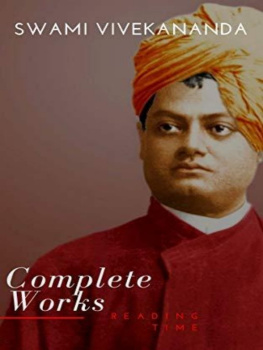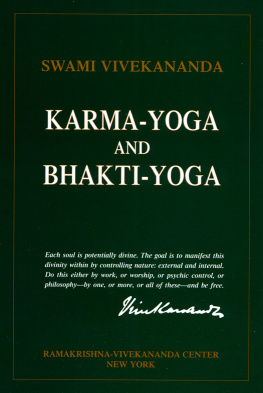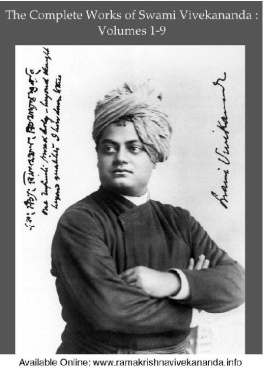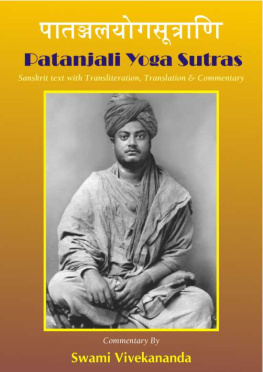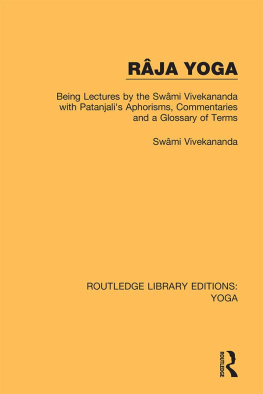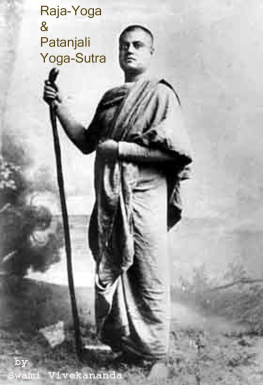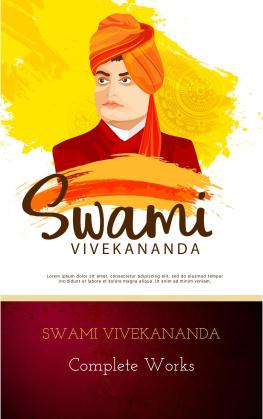Swami Vivekananda - The Complete Works of Swami Vivekananda (Total 9+1 Volumes)
Here you can read online Swami Vivekananda - The Complete Works of Swami Vivekananda (Total 9+1 Volumes) full text of the book (entire story) in english for free. Download pdf and epub, get meaning, cover and reviews about this ebook. year: 2020, publisher: Advaita Ashrama, genre: Religion. Description of the work, (preface) as well as reviews are available. Best literature library LitArk.com created for fans of good reading and offers a wide selection of genres:
Romance novel
Science fiction
Adventure
Detective
Science
History
Home and family
Prose
Art
Politics
Computer
Non-fiction
Religion
Business
Children
Humor
Choose a favorite category and find really read worthwhile books. Enjoy immersion in the world of imagination, feel the emotions of the characters or learn something new for yourself, make an fascinating discovery.
- Book:The Complete Works of Swami Vivekananda (Total 9+1 Volumes)
- Author:
- Publisher:Advaita Ashrama
- Genre:
- Year:2020
- Rating:3 / 5
- Favourites:Add to favourites
- Your mark:
The Complete Works of Swami Vivekananda (Total 9+1 Volumes): summary, description and annotation
We offer to read an annotation, description, summary or preface (depends on what the author of the book "The Complete Works of Swami Vivekananda (Total 9+1 Volumes)" wrote himself). If you haven't found the necessary information about the book — write in the comments, we will try to find it.
Note for the eBook Version of the Complete Works of Swami Vivekananda......Page 60
Publishers Note......Page 62
Preface to the First Edition......Page 65
Introduction......Page 67
1.1.1 Response to Welcome......Page 74
1.1.2 Why We Disagree......Page 76
1.1.3 Paper on Hinduism......Page 77
1.1.4 Religion Not the Crying Need of India......Page 88
1.1.5 Buddhism, the Fulfilment of Hinduism......Page 89
1.1.6 Address at the Final Session......Page 91
1.2.1 Chapter 1: Karma in Its Effect on Character......Page 92
1.2.2 Chapter 2: Each Is Great in His Own Place......Page 99
1.2.3 Chapter 3: The Secret of Work......Page 112
1.2.4 Chapter 4: What Is Duty?......Page 120
1.2.5 Chapter 5: We Help Ourselves, Not the World......Page 126
1.2.6 Chapter 6: Non-Attachment Is Complete Self-Abnegation......Page 133
1.2.7 Chapter 7: Freedom......Page 143
1.2.8 Chapter 8: The Ideal of Karma-Yoga......Page 153
1.3.0 Preface......Page 161
1.3.1 Chapter 1: Introductory......Page 163
1.3.2 Chapter 2: The First Steps......Page 173
1.3.3 Chapter 3: Prana......Page 180
1.3.4 Chapter 4: The Psychic Prana......Page 190
1.3.5 Chapter 5: The Control of Psychic Prana......Page 195
1.3.6 Chapter 6: Pratyahara and Dharana......Page 199
1.3.7 Chapter 7: Dhyana and Samadhi......Page 204
1.3.8 Chapter 8: Raja-Yoga in Brief......Page 212
1.3.9.0 Introduction......Page 217
1.3.9.1 Concentration: Its Spiritual Uses......Page 221
1.3.9.2 Concentration: Its Practice......Page 250
1.3.9.3 Powers......Page 278
1.3.9.4 Independence......Page 293
1.3.9.5 Appendix......Page 307
1.4.1 Soul, God and Religion......Page 315
1.4.2 The Hindu Religion......Page 325
1.4.3 What Is Religion?......Page 327
1.4.4 Vedic Religious Ideals......Page 336
1.4.5 The Vedanta Philosophy......Page 346
1.4.6 Reason and Religion......Page 352
1.4.7 Vedanta as a Factor in Civilisation......Page 365
1.4.8 The Spirit and Influence of Vedanta......Page 368
1.4.9 Steps of Hindu Philosophic Thought......Page 372
1.4.10 Steps to Realisation......Page 381
1.4.11 Vedanta and Privilege......Page 391
1.4.12 Privilege......Page 400
1.4.13 Krishna......Page 406
1.4.14 The Gita I......Page 412
1.4.15 The Gita Ii......Page 422
1.4.16 The Gita Iii......Page 428
1.4.17 Mohammed......Page 439
1.4.18 Vilvamangala......Page 442
1.4.19 The Soul and God......Page 444
1.4.20 Breathing......Page 455
1.4.21 Practical Religion: Breathing and Meditation......Page 463
Complete Works, Vol. 2......Page 470
2.1 Work and Its Secret......Page 471
2.2 The Powers of the Mind......Page 477
2.3 Hints on Practical Spirituality......Page 488
2.4 Bhakti or Devotion......Page 499
2.5.1 Chapter 1: The Necessity of Religion......Page 512
2.5.2 Chapter 2: The Real Nature of Man......Page 521
2.5.3 Chapter 3: Maya and Illusion......Page 535
2.5.4 Chapter 4: Maya and the Evolution of the Conception of God......Page 548
2.5.5 Chapter 5: Maya and Freedom......Page 558
2.5.6 Chapter 6: The Absolute and Manifestation......Page 567
2.5.7 Chapter 7: God in Everything......Page 578
2.5.8 Chapter 8: Realisation......Page 587
2.5.9 Chapter 9: Unity in Diversity......Page 602
2.5.10 Chapter 10: The Freedom of the Soul......Page 612
2.5.11a Chapter 11a: The Cosmos......Page 623
2.5.11b Chapter 11b: The Cosmos......Page 630
2.5.12 Chapter 12: Immortality......Page 641
2.5.13 Chapter 13: The Atman......Page 650
2.5.14 Chapter 14: The Atman: Its Bondage and Freedom......Page 663
2.5.15 Chapter 15: The Real and the Apparent Man......Page 669
2.6.1 Practical Vedanta: Part 1......Page 689
2.6.2 Practical Vedanta: Part 2......Page 702
2.6.3 Practical Vedanta: Part 3......Page 717
2.6.4 Practical Vedanta: Part 4......Page 727
2.6.5 The Way to the Realisation of a Universal Religion......Page 741
2.6.6 The Ideal of a Universal Religion......Page 753
2.6.7 The Open Secret......Page 770
2.6.8 The Way to Blessedness......Page 777
2.6.9 Yajnavalkya and Maitreyi......Page 784
2.6.10 Soul, Nature, and God......Page 789
2.6.11 Cosmology......Page 795
2.6.12 A Study of the Sankhya Philosophy......Page 803
2.6.13 Sankhya and Vedanta......Page 811
2.6.14 The Goal......Page 818
2.7.2 Divinity of Man......Page 828
2.7.3 Swami Vivekananda on India......Page 830
2.7.4 Religious Harmony......Page 832
2.7.5 From Far Off India......Page 834
2.7.6 An Evening With Our Hindu Cousins......Page 835
2.7.7 The Manners and Customs of India......Page 837
2.7.8 The Religions of India......Page 839
2.7.9 Sects and Doctrines in India......Page 841
2.7.10 Less Doctrine and More Bread......Page 842
2.7.11 The Religion of Buddha......Page 843
2.7.12 All Religions Are Good......Page 846
2.7.13 The Hindu View of Life......Page 848
2.7.14 Ideals of Womanhood......Page 851
2.7.15 True Buddhism......Page 854
2.7.16 Indias Gift to the World......Page 857
2.7.18 Some Customs of the Hindus......Page 860
Complete Works, Vol. 3......Page 863
3.1.1 Unity, the Goal of Religion......Page 864
3.1.2 The Free Soul......Page 868
3.1.3 One Existence Appearing as Many......Page 878
3.2.1 Chapter 1: Definition of Bhakti......Page 885
3.2.2 Chapter 2: The Philosophy of Ishvara......Page 890
3.2.3 Chapter 3: Spiritual Realisation, the Aim of Bhakti-Yoga......Page 895
3.2.4 Chapter 4: The Need of Guru......Page 897
3.2.5 Chapter 5: Qualifications of the Aspirant and the Teacher......Page 899
3.2.6 Chapter 6: Incarnate Teachers and Incarnation......Page 904
3.2.7 Chapter 7: The Mantra: Om: Word and Wisdom......Page 907
3.2.8 Chapter 8: Worship of Substitutes and Images......Page 910
3.2.9 Chapter 9: The Chosen Ideal......Page 912
3.2.10 Chapter 10: The Method and the Means......Page 914
3.3.1 Chapter 1: The Preparatory Renunciation......Page 918
3.3.2 Chapter 2: The Bhaktas Renunciation Results From Love......Page 921
3.3.3 Chapter 3: The Naturalness of Bhakti-Yoga and Its Central Secret......Page 924
3.3.4 Chapter 4: The Forms of Love Manifestation......Page 925
3.3.5 Chapter 5: Universal Love and How It Leads to Self-Surrender......Page 927
3.3.6 Chapter 6: The Higher Knowledge and the Higher Love Are One to the True Lover......Page 930
3.3.7 Chapter 7: The Triangle of Love......Page 931
3.3.8 Chapter 8: The God of Love Is His Own Proof......Page 934
3.3.9 Chapter 9: Human Representations of the Divine Ideal of Love......Page 936
3.3.10 Chapter 10: Conclusion......Page 941
3.4.1 First Public Lecture in the East......Page 942
3.4.2 Vedantism......Page 953
3.4.3 Reply to the Address of Welcome at Pamban......Page 969
3.4.4 Address at the Rameswaram Temple on Real Worship......Page 972
3.4.5 Reply to the Address of Welcome at Ramnad......Page 974
3.4.6 Reply to the Address of Welcome at Paramakudi......Page 983
3.4.7 Reply to the Address of Welcome at Shivaganga and Manamadura......Page 989
3.4.8 Reply to the Address of Welcome at Madura......Page 993
3.4.9 The Mission of the Vedanta......Page 999
3.4.10 Reply to the Address of Welcome at Madras......Page 1017
3.4.11 My Plan of Campaign......Page 1023
3.4.12 Vedanta in Its Application to Indian Life......Page 1039
3.4.13 The Sages of India......Page 1054
3.4.14 The Work Before Us......Page 1071
3.4.15 The Future of India......Page 1083
3.4.16 on Charity......Page 1099
3.4.17 Address of Welcome Presented at Calcutta and Reply......Page 1100
3.4.18 The Vedanta in All Its Phases......Page 1112
3.4.19 Address of Welcome at Almora and Reply......Page 1134
3.4.20 Vedic Teaching in Theory and Practice......Page 1138
3.4.21 Bhakti......Page 1139
3.4.22 The Common Bases of Hinduism......Page 1146
3.4.23 Bhakti......Page 1161
3.4.24 The Vedanta......Page 1167
3.4.25 Vedantism......Page 1201
3.4.26 The Influence of Indian Spiritual Thought in England......Page 1206
3.4.27 Sannyasa: Its Ideal and Practice......Page 1211
3.4.28 What Have I Learnt?......Page 1213
3.4.29 The Religion We Are Born In......Page 1216
3.5.1 India: Her Religion and Customs......Page 1223
3.5.2 Hindus at the Fair......Page 1228
3.5.3 at the Parliament of Religions......Page 1230
3.5.4 Personal Traits......Page 1233
3.5.5 Reincarnation......Page 1234
3.5.6 Hindu Civilisation......Page 1235
3.5.7 An Interesting Lecture......Page 1236
3.5.8 The Hindoo Religion......Page 1237
3.5.9 The Hindoo Monk......Page 1238
3.5.10 Plea for Tolerance......Page 1240
3.5.11 Manners and Customs in India......Page 1242
3.5.12 Hindoo Philosophy......Page 1246
3.5.13 Miracles......Page 1248
3.5.14 The Divinity of Man......Page 1249
3.5.15 The Love of God......Page 1254
3.5.16 The Women of India......Page 1256
3.6 Buddhistic India......Page 1260
4.1.1 The Preparation......Page 1282
4.1.2 The First Steps......Page 1289
4.1.3 The Teacher of Spirituality......Page 1296
4.1.4 The Need of Symbols......Page 1306
4.1.5 The Chief Symbols......Page 1311
4.1.6 The Ishta......Page 1320
4.2.1 The Ramayana......Page 1327
4.2.2 The Mahabharata......Page 1339
4.2.3 Thoughts on the Gita......Page 1358
4.2.4 The Story of Jada Bharata......Page 1364
4.2.5 The Story of Prahlada......Page 1367
4.2.6 The Great Teachers of the World......Page 1371
4.2.7 on Lord Buddha......Page 1382
4.2 8 Christ, the Messenger......Page 1384
4.2.9 My Master......Page 1396
4.2.10 Indian Religious Thought......Page 1423
4.2.11 The Basis for Psychic or Spiritual Research......Page 1426
4.2.12 on Art in India......Page 1429
4.2.13 Is India a Benighted Country?......Page 1430
4.2.14 The Claims of Religion......Page 1434
4.2.15 Concentration......Page 1446
4.2.16 Meditation......Page 1453
4.2.17 The Practice of Religion......Page 1461
4.3.1 Is the Soul Immortal?......Page 1471
4.3.2 Reincarnation......Page 1474
4.3.3 on Dr. Paul Deussen......Page 1486
4.3.4 on Professor Max Mller......Page 1491
4.3.5 Sketch of the Life of Pavhari Baba......Page 1494
4.3.6 Aryans and Tamilians......Page 1505
4.3.7 The Social Conference Address......Page 1511
4.3.8 Indias Message to the World......Page 1516
4.3.9 Stray Remarks on Theosophy......Page 1524
4.3.10 Reply to the Address of the Maharaja of Khetri......Page 1526
4.3.11 Reply to the Madras Address......Page 1535
4.3.12 A Message of Sympathy to a Friend......Page 1553
4.3.13 What We Believe In......Page 1554
4.3.14 Our Duty to the Masses......Page 1558
4.3.15 Reply to the Calcutta Address......Page 1561
4.3.16 to My Brave Boys......Page 1562
4.3.17 A Plan of Work for India......Page 1565
4.3.18 Fundamentals of Religion......Page 1567
4.4.1 Kali the Mother......Page 1575
4.4.2 Angels Unawares......Page 1577
4.4.3 to the Awakened India......Page 1580
4.4.4 Requiescat in Pace......Page 1583
4.4.5 Hold on Yet a While, Brave Heart......Page 1584
4.4.6 Nirvanashatkam, or Six Stanzas on Nirvana......Page 1585
4.4.7 The Song of the Sannysin......Page 1587
4.4.8 Peace......Page 1592
4.5.1 The Problem of Modern India and Its Solution......Page 1593
4.5.2 Ramakrishna: His Life and Sayings......Page 1601
4.5.3 The Paris Congress of the History of Religions......Page 1611
4.5.4 Knowledge: Its Source and Acquirement......Page 1617
4.5.5 Modern India......Page 1623
4.5.6 The Education That India Needs......Page 1657
4.5.7 Our Present Social Problems......Page 1662
4.6.1 to a Friend......Page 1666
4.6.2 The Hymn of Creation......Page 1672
4.6.3 The Hymn of Samadhi......Page 1673
4.6.4 A Hymn to the Divine Mother......Page 1674
4.6.5 A Hymn to Shiva......Page 1677
4.6.6 A Hymn to the Divinity of Shri Ramakrishna......Page 1680
4.6.7 And Let Shyama Dance There......Page 1683
4.6.8 A Song I Sing to Thee......Page 1689
Complete Works, Vol. 5......Page 1698
5.1.1 Fakir......Page 1700
5.1.2 Panditji Maharaj......Page 1701
5.1.3 Alasinga......Page 1702
5.1.4 Alasinga......Page 1707
5.1.5 Alasinga......Page 1714
5.1.6 Haripada......Page 1720
5.1.7 Friends......Page 1722
5.1.8 Alasinga......Page 1724
5.1.9 Sharat......Page 1726
5.1.10 Alasinga......Page 1727
5.1.11 Alasinga......Page 1729
5.1.12 Sister......Page 1731
5.1.13 Alasinga......Page 1733
5.1.14 Alasinga......Page 1736
5.1.16 Sister......Page 1737
5.1.17 Alasinga......Page 1738
5.1.18 Alasinga......Page 1739
5.1.19 Vehemia......Page 1740
5.1.20 Sister......Page 1741
5.1.21 Alasinga......Page 1742
5.1.22 Alasinga......Page 1744
5.1.24 Alasinga......Page 1746
5.1.25 Alasinga......Page 1747
5.1.26 Dharmapala......Page 1750
5.1.27 Alasinga......Page 1751
5.1.28 Mrs. Bull......Page 1753
5.1.29 G. G.......Page 1754
5.1.30 Alasinga......Page 1756
5.1.31 Mrs. Ole Bull......Page 1758
5.1.32 Sister......Page 1759
5.1.34 Sister......Page 1763
5.1.36 Sister......Page 1764
5.1.37 Alasinga......Page 1766
5.1.38 S--......Page 1767
5.1.39 Alasinga......Page 1768
5.1.40 Alasinga......Page 1771
5.1.42 Kidi......Page 1772
5.1.43 Alasinga......Page 1773
5.1.44 Mrs. William Sturges......Page 1775
5.1.45 Mother......Page 1776
5.1.46 Friend......Page 1777
5.1.47 Maharaja of Khetri......Page 1778
5.1.49 Alasinga......Page 1779
5.1.50 Mrs. Bull......Page 1780
5.1.51 Sturdy......Page 1781
5.1.52 Alasinga......Page 1782
5.1.53 Alasinga......Page 1783
5.1.54 Alasinga......Page 1784
5.1.55 Alasinga......Page 1785
5.1.56 Sister......Page 1786
5.1.57 Blessed and Beloved......Page 1787
5.1.58 Alasinga......Page 1790
5.1.60 Alasinga......Page 1792
5.1.61 Nanjunda Rao......Page 1793
5.1.62 Nanjunda Rao......Page 1794
5.1.63 Alasinga......Page 1795
5.1.64 Alasinga......Page 1796
5.1.65 Blessed and Beloved......Page 1798
5.1.66 Nanjunda Rao......Page 1799
5.1.67 Alasinga......Page 1800
5.1.68 Alasinga......Page 1802
5.1.69 Alasinga......Page 1804
5.1.70 Indian Mirror......Page 1806
5.1.72 Alasinga......Page 1807
5.1.73 Madam......Page 1809
5.1.74 Honoured Madam......Page 1810
5.1.75 Doctor Shashi......Page 1812
5.1.76 Mr.__......Page 1814
5.1.77 Sarat Chandra......Page 1815
5.1.78 Sister......Page 1817
5.1.79 Mother......Page 1821
5.1.81 Jagmohanlal......Page 1822
5.1.83 Your Highness......Page 1823
5.1.84 Your Highness......Page 1824
5.1.85 Your Highness......Page 1825
5.1.87 Your Highness......Page 1826
5.1.89 Mother......Page 1827
5.1.90 Joe......Page 1831
5.1.91 Friend......Page 1832
5.1.93 Shashi......Page 1833
5.1.94 Mother......Page 1834
5.1.95 Sturdy......Page 1836
5.1.96 Mother......Page 1837
5.1.97 Shashi......Page 1838
5.1.98 Mother......Page 1839
5.1.100 Joe......Page 1840
5.1.101 Mother......Page 1841
5.1.102 Swarup......Page 1842
5.1.103 Mary......Page 1843
5.1.104 Shashi......Page 1844
5.1.105 Joe......Page 1846
5.1.107 Joe......Page 1848
5.1.108 Mary......Page 1849
5.1.110 Mary......Page 1851
5.1.111 Blessed and Beloved......Page 1853
5.1.112 Blessed and Beloved......Page 1854
5.1.114 Swarup......Page 1855
5.1.115 Mother......Page 1857
5.1.117 Rakhal......Page 1859
5.1.118 Rakhal......Page 1860
5.1.119 Rakhal......Page 1861
5.1.120 Rakhal......Page 1862
5.1.122 Joe......Page 1863
5.1.123 Dhira Mata......Page 1864
5.2.1 Miracles......Page 1865
5.2.2 An Indian Yogi in London......Page 1867
5.2.3 Indias Mission......Page 1870
5.2.4 India and England......Page 1875
5.2.5 Indian Missionarys Mission to England......Page 1881
5.2.6 With the Swami Vivekananda at Madura......Page 1883
5.2.7 The Abroad and the Problems at Home......Page 1888
5.2.8 The Missionary Work of the First Hindu Sannyasin......Page 1895
5.2.9 Reawakening of Hinduism on a National Basis......Page 1901
5.2.10 on Indian Women Their Past, Present and Future......Page 1903
5.2.11 on the Bounds of Hinduism......Page 1907
5.3.1 on Karma-Yoga......Page 1910
5.3.2 on Fanaticism......Page 1913
5.3.3 Work Is Worship......Page 1915
5.3.4 Work Without Motive......Page 1916
5.3.5 Sadhanas or Preparations for Higher Life......Page 1918
5.3.6 The Cosmos and the Self......Page 1923
5.3.8 on Art......Page 1925
5.3.9 on Language......Page 1926
5.3.11 The Sannyasin and the Householder......Page 1927
5.3.12 The Evils of Adhikarivada......Page 1929
5.3.13 on Bhakti-Yoga......Page 1931
5.3.14 Ishvara and Brahman......Page 1934
5.3.15 on Jnana-Yoga......Page 1935
5.3.16 The Cause of Illusion......Page 1940
5.3.17 Evolution......Page 1941
5.3.18 Buddhism and Vedanta......Page 1942
5.3.19 on the Vedanta Philosophy......Page 1944
5.3.20 Law and Freedom......Page 1948
5.3.21 The Goal and Methods of Realisation......Page 1952
5.3.22 World-Wide Unity......Page 1953
5.3.23 The Aim of Raja-Yoga......Page 1954
5.4.1 Discussions at the Graduate Philosophical Society......Page 1955
5.4.2 at the 20th Century Club of Boston, Usa......Page 1967
5.4.3 at the Brooklyn Ethical Society, Brooklyn, U.S.A.......Page 1968
5.4.4 Selections From the Math Diary......Page 1970
5.4.5 Yoga, Vairagya, Tapasya, Love......Page 1975
5.4.6 in Answer to Nivedita......Page 1976
5.4.7 Guru, Avatara, Yoga, Japa, Seva......Page 1977
5.5.1 Shri Surendra Nath Das Gupta......Page 1982
5.5.2 Shri Surendra Nath Sen......Page 1985
5.5.3 Shri Priya Nath Sinha......Page 2000
5.5.4 Sarat Chandra Chakravarty......Page 2025
5.6 Sayings and Utterances......Page 2049
5.7.1 Reason, Faith and Love......Page 2062
5.7.2 Six Sanskrit Mottoes......Page 2065
5.7.3 The Message of Divine Wisdom......Page 2066
5.7.4 The Belur Math: An Appeal......Page 2072
5.7.5 The Advaita Ashrama, Himalayas......Page 2073
5.7.6 The Ramakrishna Home of Service Varanasi: An Appeal......Page 2074
5.7.7 Who Knows How Mother Plays!......Page 2076
5.7.8 to the Fourth of July......Page 2077
5.7.9 The East and the West......Page 2079*And More Volumes...
Swami Vivekananda: author's other books
Who wrote The Complete Works of Swami Vivekananda (Total 9+1 Volumes)? Find out the surname, the name of the author of the book and a list of all author's works by series.

